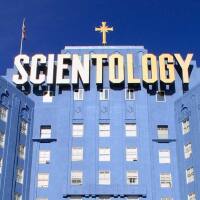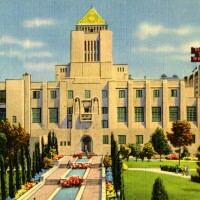Los Angeles in Buildings: City Hall

The thin spread of development over great distances; the strict separation of residential buildings from those of commerce and industry; the caps on height and density: these conditions may now look like Los Angeles' most crippling and intractable disorders, but they once promised a cure for all that ailed the American city. The bigger Los Angeles boomed in the late 19th and early 20th centuries, the more those in charge of its form did to retain the feeling (or so they imagined it) of the small inland towns from which so many new Angelenos had arrived. To others this unusually low-rise new city offered an escape from the much-bemoaned “dark, walled-in streets” amid “concrete canyons” of the industrial metropolises of the east coast and Europe. And so, for 36 years, just one structure loomed especially large over Los Angeles' undisturbed horizontality: City Hall.


A 1905 ordinance having prohibited the construction of buildings taller than 150 feet, for many years “you couldn't see the Los Angeles skyline from the City Hall observation deck,” as Los Angeles Times architecture critic John Pastier put it, “because you were in it.” But you could see the results of a resolve, spelled grandly out in a 1910 city planning committee report, to arrange “the development of our great city along broad and harmonious lines of beauty and symmetry.” Those words evince the local influence of the “City Beautiful” planning movement then in vogue across the country, as does the design for Los Angeles' Central Library by Bertram Goodhue as well as that of the next important building that went under construction: City Hall, designed by the trio of John Parkinson, Albert C. Martin, and John C. Austin, the leading architects of 1920s Los Angeles.
The city's municipal government had occupied five different locations over the previous 75 years, starting with a rented hotel in the 1850s and by 1888 occupying an acclaimed Romanesque Revival building on Broadway. (“An honor to the commonwealth,” the Los Angeles Times said of the structure which has since become a surface parking lot next to the newspaper's own garage.) But the time had come for a more serious work of governmental architecture, which, under the banner of Allied Architects, the dream team of Parkinson, Martin, and Austin looked more than able to provide. As the designer of the Braly Block, the Security Building, and the A.G. Bartlett Building, then the three tallest in Los Angeles, Parkinson had already contributed to the city much of what height it had. Austin brought to the table a monumental sensibility developed in projects like the Hollywood Masonic Temple and Shrine Auditorium. Martin, founder of the architectural firm that would grow over successive generations into the formidable A.C. Martin Partners, had drawn up the impressive Thomas Higgins Building and Million Dollar Theater downtown.

Writing in Architectural Forum in 1928, the year City Hall opened, Austin emphasized a “point interesting to all architects,” and not just in Los Angeles: that “a municipality is not governed by its own ordinances; therefore, public buildings can be built to any height.” Still, the exceptional height of City Hall required a public referendum: the drawings that Austin, Parkinson, and Martin presented included a tower rising to a comparatively colossal 454 feet, despite the fact that the Los Angeles municipal government could then fit comfortably into just four of its 28 floors. Martin explained that excessive-looking central element as “one of the most efficient parts of the structure,” offering not just “a distinctly beautiful profile” but one that “eliminates the possibility of Los Angeles having to spend money in a few years to house the city's business.”
As well as Martin and his collaborators understood the efficiency of verticality as a means of accommodating growth — though both of those collaborators did serve on the commission that limited building height in the first place — it would take the city itself more than half a century to start internalizing the idea. More to the priorities of the time, the Board of Public Works praised the architects for having come up with an “eminently satisfactory and beautiful design” that resulted in a “monumental building.” Built with concrete incorporating sand from each of California's 58 counties and water from each of its 21 missions (as one still often hears), its mix-and-match “modern American” style draws that monumentality from many a source, including Goodhue's Nebraska State Capitol (a building inscribed, like Los Angeles' Central Library and City Hall, with words provided by University of Nebraska philosophy professor Hartley Burr Alexander) and, to top off the tower, the ancient Mausoleum at Halicarnassus.


What City Hall may lack in iconic recognizability it makes up for with an almost subconscious symbolic power. Though few Angelenos could draw the building from memory, they have seen it over and over again, and so, at this point, has much of the rest of the world. Every LAPD badge has borne its image since 1940, and the building began playing its series of major roles in television shows like “Dragnet,” “Perry Mason,” and “The Adventures of Superman.” A localized 1953 adaptation of H.G. Wells' “The War of the Worlds” even blew it up, at least in scale model, setting off a cinematic tradition of felling the large buildings of Los Angeles. “Hollywood destroys Los Angeles because it’s there,” writes Thom Andersen in “Los Angeles Plays Itself,” his documentary about the city's representation in film and television. “Our filmmakers don’t really believe the Los Angeles City Hall is a more resonant civic symbol than the Empire State Building. But they are well aware that it’s closer.”
Prince played down the building's authority and played up its luxury in the music video for his 1991 song “Diamonds and Pearls,” which turns its interior into a purple-lit harem and its front steps into a concert stage. The idea of Los Angeles' City Hall and its environs as a performance space, which must have seemed quite imaginative at the time, became something more like an expectation 20 years later with the building of Grand Park, a kind of “front lawn,” programmed year-round with events, that stretches all the way to the Music Center up on Bunker Hill. Anyone familiar with past eras of Los Angeles has to be impressed at the sheer quantity of public space Grand Park offers, if not certain aspects of that space's quality: anyone who attempts a Prince-style performance on the City Hall steps will find themselves cut off from the park by Spring Street.
That not one but a total of three streets run through Grand Park shows that Los Angeles has come to an understanding more of the importance of such urban spaces than of their mechanics. But then, the urbanization of Los Angeles has arguably taken one step back with every two it takes forward ever since the end of the 150-foot height limitation in 1958, which came along with a set of parking requirements nearly as onerous as the law repealed. (A.C. Martin Partners, perhaps due to its long history in Los Angeles, has ways of succeeding within its self-imposed limitations: they designed the Union Bank Tower, the city's first post-repeal skyscraper, as well as the Wilshire Grand Center, the tallest building in Los Angeles today.)

The precedent of City Hall itself as a site of spectacle actually dates back to its opening day in 1928 — or rather, its opening three days, the length of its epic dedication celebration involving a three-mile-long parade, hundreds of floats, aerial bombs that happened to shatter a few of the building's newly installed windows, Civil War veterans, a performance by Irving Berlin, and the entire lighting supply of MGM, all directed by movie-palace magnate Sid Grauman. To cap off the festivities, President Calvin Coolidge pushed a button in the White House that lit up the Colonel Charles Lindbergh Beacon that capped off the building – an event witnessed by young Lindbergh himself, who had completed his famous trans-Atlantic flight during City Hall's construction.
“For thirty minutes the building was kept dark as the beaming beacon turned silently on its pivot and cast the message of Los Angeles' civic progress and development as an aviation center,” reported the Times. But when the Lindbergh Beacon, by that point already replaced with a non-rotating red light, went dark after Pearl Harbor, it wouldn't enter service again until the 21st century. City Hall underwent $299 million worth of renovations and seismic upgrades performed on in the 1990s and early 2000s, but by the time of the building's rededication ceremony in 2002, Los Angeles found itself in a long low point of civic pride, so much so that certain areas considered seceding from the city. “This is the City Hall of Venice, of San Pedro and of Valley Village,” said Mayor James Hahn to the crowd of about a thousand. “This is the City Hall of a great, great city. Some want to break up this city, but I don't think we should allow that to happen.”


The secessions didn't happen, but one can still safely call Hahn's words less inspired, in every sense, than the ones printed in the program of City Hall's original 1928 celebration:
The Spirit of the dedication of this white monumental monolith which is the new City Hall is the spirit of Los Angeles – the spirit of a forward-looking people, determined to win a happy community Destiny. This monument symbolizes the soul of a struggling, fighting, building people, never knowing defeat and always climbing upward, until today it may be said of them: “This is their City. They have created it; they have transformed it from a sleepy Spanish-California pueblo to one of the mightiest communities of a continent.” It is dedicated to the men of action who aroused the drowsing pueblo from its peaceful laziness, said “Let us build here a city!” and created a surge of ambition that in the brief span of three-quarters of a century the little town of 1600 souls became a mighty metropolis of nearly one and one-half millions of people.
But Angeleno attitudes, so often characterized in the later decades of the 20th century by self-disparaging resignation, have in recent years turned to some degree back toward the proud, optimistic triumphalism of old (adhere though their expression now may to a stricter modern sense of political correctness), or at least a renewed civic pride.
That process has gone hand in hand with the development of Los Angeles' public space: closing to cars the roads that segment it, Grand Park draws tens of thousands (many of whom take the city's expanding subway system there) every December 31 to watch the light shows, more elaborate each time, projected onto City Hall's concrete surfaces. Even the Lindbergh Beacon sits reinstalled and ready for illumination, along with the customizable colored lighting lining the building below, on important occasions: not just New Year's Eve, but Lakers and Dodgers victories, shows of solidarity with disaster-inflicted foreign countries, and, last year, the death of Prince. City Hall may have fallen from its status as the tallest building in Los Angeles by far to 30th place, but what other tower in the city could pull off the color purple?



